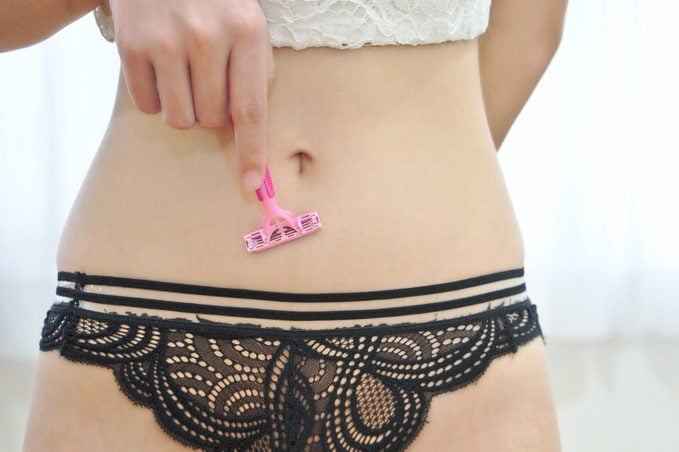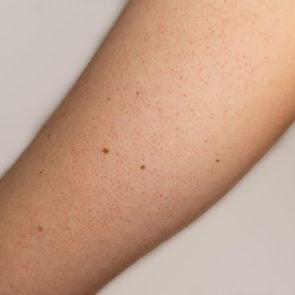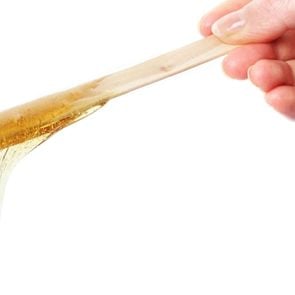Here’s Why You Get Ingrown Pubic Hairs—And How to Get Rid of Them
Updated: May 02, 2023
Ingrown pubic hairs are common, especially for people who groom their pubic hair. Here's what you can do to get rid of them, according to dermatologists.
Pubic hair basics
Most people have pubic hair. It does have a purpose, helping to reduce friction during sex and protecting against bacteria or other germs. But what you choose to do, or not do, with your pubic hair is your business. Some people opt to groom, trim, shave, or wax unwanted pubic hair, others leave it alone. No matter what your grooming preferences are, you’ve probably experienced a pesky ingrown pubic hair here or there.
Here’s what doctors want you to know about why ingrown pubic hairs happen, and how to avoid them.
This Is How Often Most People Masturbate, Say Doctors & Recent Data
What are ingrown hairs?
Ingrown hairs are more likely to occur after hair is waxed, tweezed, or shaved, and it happens when the hair grows back into the skin instead of rising up from it to the surface, according to Lucy Chen, MD, a Miami board-certified dermatologist of Riverchase Dermatology.
The result is a round bump on the skin that may result in some pain, itching, or redness, and can cause inflammation as the body tries to get rid of the hair, adds board-certified dermatologist Morgan Rabach, MD, of LMMedical in New York.
It sometimes looks like acne, says board-certified dermatologist Zain Husain, MD, founder of NJ Dermatology and Aesthetics Center. You might even see may see a solid or pus-filled bump.
7 Skin Conditions That Look Like Acne But Aren’t
What ingrown pubic hairs aren’t
Although they may seem similar at first glance, ingrown pubic hairs are not the same as vaginal acne.
“Vaginal acne will have pus, while ingrown hairs may not, and ingrown pubic hair contains trapped hair, while vaginal acne does not,” Dr. Chen says. Ingrown hairs will first look like tender, red bumps, and pus will accumulate only if bacterial growth leads to an infection.
Folliculitis, which is inflammation around the hair follicles, is also very common in areas where people shave, according to Dr. Rabach. In vaginal folliculitis, inflammation occurs with each individual hair follicle, but the follicle is straight and coming out of the skin. This differs from ingrown hair, where the hair follicle is bent and contained under the skin, Dr. Rabach explains.
Some sexually transmitted infections (STIs), such as herpes, can cause bumps that may look similar or be mistaken for ingrown pubic hairs, Dr. Chen says. Ingrown pubic hairs are usually single bumps, while genital herpes is typically a cluster of sores or lesions. Herpes also causes other symptoms that ingrown hairs do not, such as headache and fever. Herpes or genital wart outbreaks can go away and then return again.
Talk with your doctor if you have bumps you can’t identify or if they don’t go away in two weeks.
What Is Vaginal Atrophy? Women’s Doctors Explain

Why do some people get ingrown pubic hair and others don’t?
Ingrown hairs can happen wherever there is hair on the body, but Dr. Husain notes pubic hair tends to be thick and curly, and the skin in that area is also pretty thin and delicate, making hair more susceptible to growing back in towards the skin. Some reasons include waxing or shaving too often, not shaving in the right direction, not using a moisturizer or shaving cream when shaving, or not exfoliating the bikini line regularly.
Genetics also plays a part, per Dr. Rabach. They’re also one of the reasons for excess body hair.
Basically, anyone who removes pubic hair is at a higher risk for ingrown hairs, and pubic hair removal is common. In one 2016 survey of 3,316 women published in JAMA Dermatology, 84% said they removed or trimmed pubic hair using scissors, razors, wax, tweezers, lasers, or electrolysis. So it makes sense that a lot of people experience ingrown hairs.
People with coarse or curly pubic hair, or those who shave, tweeze, or wax often are most at risk for ingrown pubic hairs. And those who wear tight clothing that rubs against the skin and irritates it may also be at a higher risk, Dr. Chen says.
“Razors create sharp edges on each hair strand, so they are more likely to grow back into the skin,” Dr. Husain says.
5 Ways Menopause Changes Your Skin (with Solutions!), from a Cosmetic Surgeon
What’s the worst-case scenario?
Ingrown hairs are typically not dangerous, but Dr. Chen says that a a cyst may develop around an ingrown pubic hair, and it can become infected or inflamed. Dr. Rabach adds that the hair can also cause an abscess, or a bump filled with pus and inflammatory cells, which may break apart and cause cellulitis, meaning the surrounding soft tissue gets infected, swollen, and red.
This would require oral antibiotics and in rare cases, even hospitalization and intravenous antibiotics, according to Dr. Rabach.
Regular ingrown hairs that don’t go away on their own may also require prescriptions, like a topical retinoid to increase cell turnover, a steroid cream to reduce inflammation, or medical removal of the hair by your doctor. “If your doctor believes you have an infection, you may need to treat the infection with antibiotics,” Dr. Husain says. “Some ingrown hairs can cause scarring or discoloration.”
How to avoid ingrown pubic hairs
Because waxing, shaving, and tweezing often lead to ingrown hairs, it makes sense that stopping hair removal treatments is one way to avoid ingrown pubic hair. But if that’s not your style, you can still groom your pubic hair and avoid ingrown hairs.
Here’s what the experts recommend to avoid ingrown pubic hairs:
- Use a sharp razor and always shave in the direction of hair growth. (Shaving in the opposite direction might give you a closer shave, but it also makes it easier for the hair to curl back towards your skin.)
- Before shaving, wet the skin with warm water.
- Use a moisturizer or shaving cream when shaving. (Shaving dry hair can cause particularly sharp hairs that are more likely to grow back towards your skin.)
- Rinse the razor with water after every stroke.
- Make sure to exfoliate the bikini line before and after shaving.
- Exfoliate surrounding skin.
Here’s What Could Happen If You Don’t Change Your Razor
Here’s what to do if you have ingrown pubic hair
If you have an ingrown pubic hair (or a few), Dr. Chen says not to shave, wax, or tweeze the area until the ingrown pubic hair goes away on its own. They often go away on their own without treatment.
“You definitely should not continue to remove hair in the affected region,” Dr. Husain says. And no matter how tempting it may be, don’t pick, dig, or squeeze at the ingrown hair. Doing so may leave a scar or lead to a skin infection.
If the hair doesn’t start to grow up through the skin, your doctor may prescribe creams to reduce inflammation and redness. You can also apply a warm compress to the area to soften the skin and allow the hair to come out. Dr. Husain says that over-the-counter products with benzoyl peroxide or exfoliating ingredients like glycolic acid or salicylic acid can help treat and prevent ingrown hairs, too.
- 5 Warning Signs You’re Settling in Your Relationship
- Research Shows This Gross (but Common) Behavior May Increase Alzheimer’s Risk
- What Is Your ‘Set Point Weight’? Here’s How To Gauge It—And Why a Doctor Says You’ll Want To
- This One Emotion Is Worse for Your Health Than Junk Food, According to a Leading Functional Medicine Doctor























